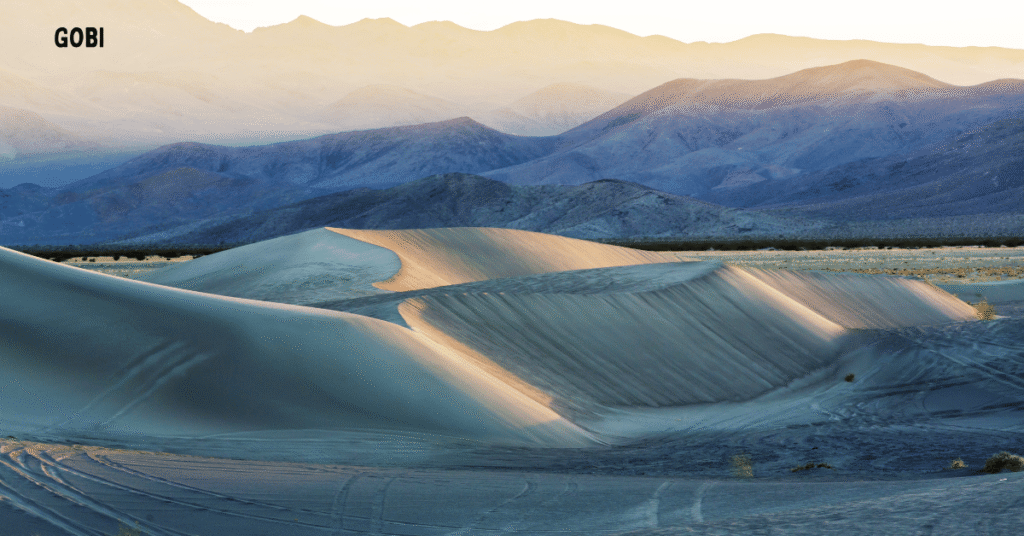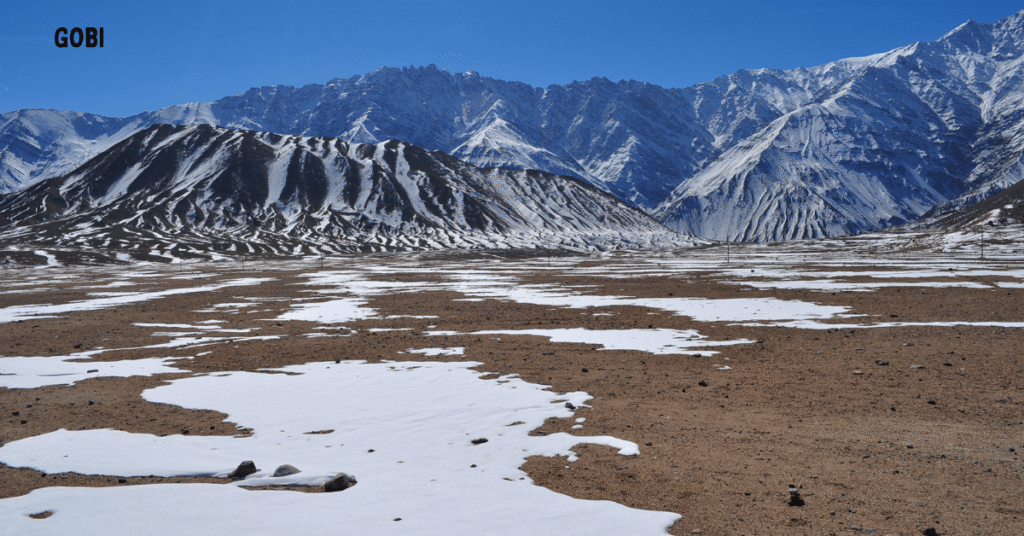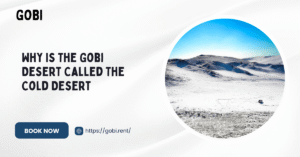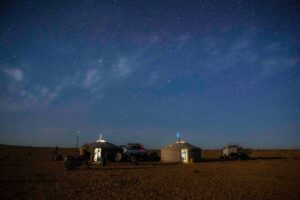The Gobi Desert is one of the most mysterious landscapes on Earth. Stretching across southern Mongolia and northern China, it is often imagined as a land of scorching sun and endless sand. While the Gobi certainly has its share of dramatic dunes and barren stretches, it carries a unique title that sets it apart from other deserts: it is known as the “cold desert.” Travelers who expect endless heat are often surprised when temperatures plummet to freezing levels, especially at night or in winter.
So, why exactly is the Gobi called the cold desert? The answer lies in its geography, climate, and location. For anyone planning to explore this remarkable region, understanding the reasons behind its extreme conditions is essential.
Geography of the Gobi Desert
The Gobi Desert is the largest desert in Asia, covering around 1.3 million square kilometers. It spreads across southern Mongolia and northern China, forming a vast expanse of rocky plains, grasslands, and rugged mountains. Unlike the sandy deserts of the Sahara, much of the Gobi’s terrain consists of bare rock and gravel.
This desert sits on a high plateau, with elevations ranging between 900 and 1,500 meters above sea level. Its northern location, far away from tropical climates, makes it more vulnerable to colder air masses coming from Siberia. This geography explains part of why the Gobi experiences frigid winters in addition to its hot summers.
What Makes the Gobi a Cold Desert?
Most people associate deserts with sweltering heat. However, deserts are not defined by temperature but by their lack of rainfall. The Gobi receives less than 200 millimeters of rain each year, which qualifies it as a desert. What makes it unusual is that it is located in a part of the world that has a continental climate.
During winter, temperatures in the Gobi can plunge to as low as -40°C. Winds sweep across the plains, and snow can blanket the rocky terrain. Summers, on the other hand, can climb above 40°C during the day. These extreme contrasts are the hallmark of a cold desert.
Climate Characteristics of the Gobi Desert
The climate of the Gobi Desert is one of the most extreme in the world. Its position, far from the ocean, means it does not benefit from moderating coastal temperatures. Instead, the desert heats up rapidly in summer and loses warmth quickly in winter.
Key features of the Gobi’s climate include:
- Extreme temperature swings: Hot during the day and freezing at night.
- Cold winters: Snow and icy winds dominate much of the desert from November to March.
- Low rainfall: With less than 200 mm annually, it is one of the driest places in Asia.
- Frequent dust storms: Especially common during spring, when strong winds lift fine particles across vast distances.
This combination of dryness and cold temperatures is what makes the Gobi so distinctive.

Seasonal Variations in the Gobi Desert
Travelers often ask what time of year is best to visit the Gobi. The answer depends on what kind of experience you’re looking for. Each season brings its own personality to the desert.
- Summer (June–August): Hot days with temperatures up to 45°C, but nights can still be chilly.
- Autunno (settembre-ottobre): Pleasant daytime temperatures, but the first frosts arrive early.
- Winter (November–March): Harsh and freezing, with temperatures well below zero. Not ideal for casual travelers.
- Spring (April–May): Cool but windy, with frequent dust storms.
For most travelers, the best months to experience the Gobi are late spring and early autumn, when conditions are more comfortable for self-drive tours.
Flora and Fauna Adaptations in the Cold Desert
Despite the harsh environment, the Gobi is far from lifeless. Plants and animals have evolved to handle both the lack of water and the biting cold.
- Flora: Saxaul trees, drought-resistant shrubs, and grasses survive in sparse patches. Their roots dig deep to find underground water.
- Fauna: Unique animals such as the wild Bactrian camel, Mongolian gazelle, snow leopard, and Gobi bear live here. The Bactrian camel, with its two humps, is particularly well adapted to storing fat and water to survive both drought and freezing winds.
These adaptations make the Gobi’s ecosystem one of the most fascinating in the world.
Human Life and Nomadic Culture in the Gobi
For centuries, nomadic herders have called the Gobi Desert home. Mongolian families move seasonally to find grazing land for their livestock, including sheep, goats, yaks, and camels. Their way of life is closely tied to the desert’s rhythm of seasons.
Yurts, also known as gers, provide shelter from both scorching sun and icy winds. Hospitality is central to nomadic culture, and visitors are often welcomed with warm tea and dairy products. For travelers driving through the desert, meeting these families offers a unique glimpse into resilience and tradition.
When exploring the Gobi on a self-drive tour, many adventurers include visits to nomadic households as part of the journey. Reliable vehicles like Toyota Land Cruisers make it possible to cross the vast terrain and reach remote communities safely.

Why Understanding Gobi’s Climate Matters for Travelers
The Gobi Desert is stunning, but its weather can catch visitors off guard. Proper preparation is key to enjoying the adventure safely.
- Clothing: Pack layers, including jackets, even in summer. Temperatures can fall dramatically at night.
- Food and Water: Supplies are limited in remote areas, so stock up before heading out.
- Vehicles: Choose a strong 4×4 capable of handling rough terrain. A car rental in Ulaanbaatar or Dalanzadgad is the best starting point for any Gobi trip.
- Planning: Be aware of the season you’re traveling in. Summers require sun protection, while autumn and spring demand windproof clothing.
Companies like Gobi Affitto make this easier by providing fully equipped Toyota Land Cruisers designed for the desert. Whether you want a self-drive Mongolia tour or a guided expedition, having the right vehicle ensures you can handle sudden weather changes and rough roads with confidence.
Conclusion
The Gobi Desert’s title as the “cold desert” is no exaggeration. Its high latitude, elevation, and distance from oceans create one of the most extreme climates on the planet. From blazing summers to bitterly cold winters, the Gobi defies stereotypes of what a desert should be.
For travelers, these conditions make the Gobi a destination like no other. Planning ahead, choosing the right season, and securing a dependable 4×4 rental are all essential steps. With Gobi Affitto, adventurers can confidently embark on self-drive Mongolia tours or guided trips, knowing they are prepared for whatever the cold desert has in store.
Whether you’re drawn by its unique climate, its nomadic culture, or its breathtaking landscapes, the Gobi Desert invites you to experience both its challenges and its beauty firsthand.
FAQs About the Cold Desert
Why does the Gobi Desert get so cold at night?
The lack of humidity and vegetation means heat escapes quickly after sunset, causing sharp drops in temperature.
Is the Gobi colder than other deserts?
Yes, compared to hot deserts like the Sahara, the Gobi experiences much lower winter temperatures, making it a true cold desert.
Quando è il momento migliore per visitare il deserto del Gobi?
Late spring (May–June) and early autumn (September) are considered the most comfortable months for travel.
What kind of vehicle is best for traveling across the Gobi?
A 4×4 like the Toyota Land Cruiser is ideal. It can handle the rugged terrain, shifting sand, and long distances between settlements.






